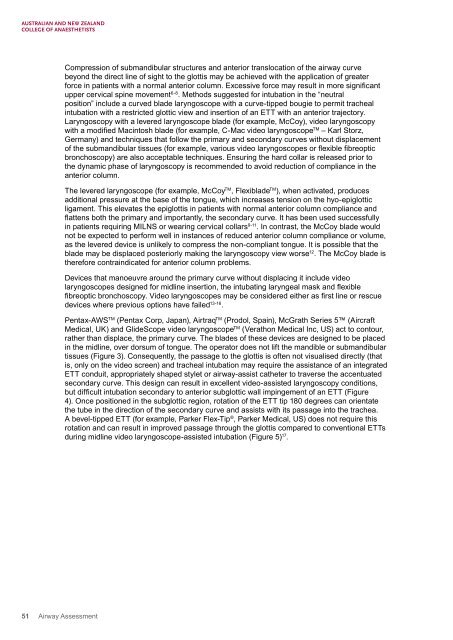Airway Assessment
2cKbSEQ
2cKbSEQ
You also want an ePaper? Increase the reach of your titles
YUMPU automatically turns print PDFs into web optimized ePapers that Google loves.
Compression of submandibular structures and anterior translocation of the airway curve<br />
beyond the direct line of sight to the glottis may be achieved with the application of greater<br />
force in patients with a normal anterior column. Excessive force may result in more significant<br />
upper cervical spine movement 6-8 . Methods suggested for intubation in the “neutral<br />
position” include a curved blade laryngoscope with a curve-tipped bougie to permit tracheal<br />
intubation with a restricted glottic view and insertion of an ETT with an anterior trajectory.<br />
Laryngoscopy with a levered laryngoscope blade (for example, McCoy), video laryngoscopy<br />
with a modified Macintosh blade (for example, C-Mac video laryngoscope TM – Karl Storz,<br />
Germany) and techniques that follow the primary and secondary curves without displacement<br />
of the submandibular tissues (for example, various video laryngoscopes or flexible fibreoptic<br />
bronchoscopy) are also acceptable techniques. Ensuring the hard collar is released prior to<br />
the dynamic phase of laryngoscopy is recommended to avoid reduction of compliance in the<br />
anterior column.<br />
The levered laryngoscope (for example, McCoy TM , Flexiblade TM ), when activated, produces<br />
additional pressure at the base of the tongue, which increases tension on the hyo-epiglottic<br />
ligament. This elevates the epiglottis in patients with normal anterior column compliance and<br />
flattens both the primary and importantly, the secondary curve. It has been used successfully<br />
in patients requiring MILNS or wearing cervical collars 9-11 . In contrast, the McCoy blade would<br />
not be expected to perform well in instances of reduced anterior column compliance or volume,<br />
as the levered device is unlikely to compress the non-compliant tongue. It is possible that the<br />
blade may be displaced posteriorly making the laryngoscopy view worse 12 . The McCoy blade is<br />
therefore contraindicated for anterior column problems.<br />
Devices that manoeuvre around the primary curve without displacing it include video<br />
laryngoscopes designed for midline insertion, the intubating laryngeal mask and flexible<br />
fibreoptic bronchoscopy. Video laryngoscopes may be considered either as first line or rescue<br />
devices where previous options have failed 13-16 .<br />
Pentax-AWS TM (Pentax Corp, Japan), Airtraq TM (Prodol, Spain), McGrath Series 5 (Aircraft<br />
Medical, UK) and GlideScope video laryngoscope TM (Verathon Medical Inc, US) act to contour,<br />
rather than displace, the primary curve. The blades of these devices are designed to be placed<br />
in the midline, over dorsum of tongue. The operator does not lift the mandible or submandibular<br />
tissues (Figure 3). Consequently, the passage to the glottis is often not visualised directly (that<br />
is, only on the video screen) and tracheal intubation may require the assistance of an integrated<br />
ETT conduit, appropriately shaped stylet or airway-assist catheter to traverse the accentuated<br />
secondary curve. This design can result in excellent video-assisted laryngoscopy conditions,<br />
but difficult intubation secondary to anterior subglottic wall impingement of an ETT (Figure<br />
4). Once positioned in the subglottic region, rotation of the ETT tip 180 degrees can orientate<br />
the tube in the direction of the secondary curve and assists with its passage into the trachea.<br />
A bevel-tipped ETT (for example, Parker Flex-Tip ® , Parker Medical, US) does not require this<br />
rotation and can result in improved passage through the glottis compared to conventional ETTs<br />
during midline video laryngoscope-assisted intubation (Figure 5) 17 .<br />
51 <strong>Airway</strong> <strong>Assessment</strong>


